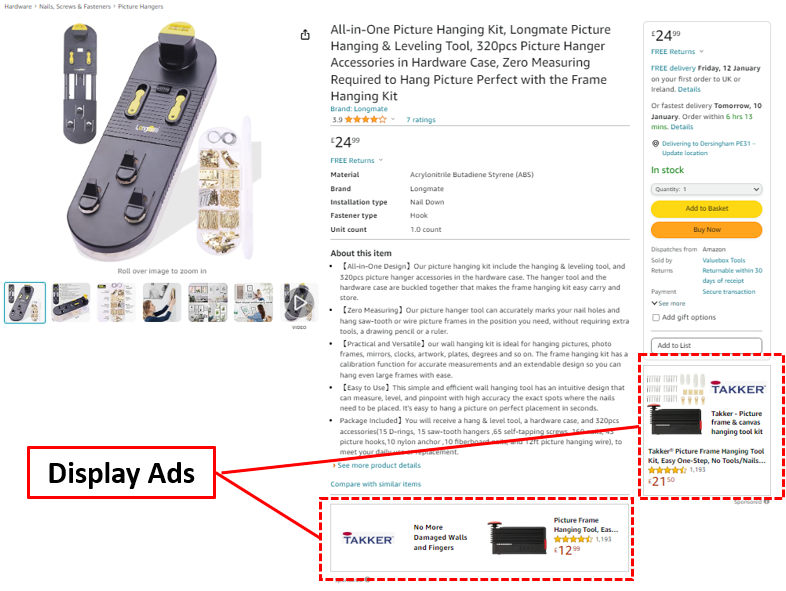If you are looking to amplify your brand visibility and drive sales across Amazon, Amazon ads will be indispensable. We collated thoughts from the team and have put a summary together below.
You need to ensure your brand and product ads are strategically positioned in front of the right Amazon consumer in search results, product pages and other placements through data analysis and application of the results.
Here we will guide you though ad types, business objectives, research foci, implementation and management of Amazon Ads.
Ad Types
Amazon Ads manifest in various forms, but this article focuses on the three core marketplace ads:
-
Sponsored Products Ads – Ads consumers see at the top, and spread through search results (see below).
-
Sponsored Brands Ads – Ads seen in banners (see below).
-
Sponsored Display Ads – Ads that either re-display the product a consumer has looked at elsewhere (on Amazon, third-party apps or sites) and vendor targeting of consumer interests (see below).
Goal Setting
We don’t want to get into wider business management, but you must have organisational buy-in, a growth mindset, and a capacity for agile, ongoing strategic and data-led functions to make ads work.
Your wider brand objectives will inform ad use, the best tools and defining the strategy. Increased sales, higher visibility, new product launches? Focus in on these objectives.
Growing your brand through ads provides ample opportunity to take regular reports and have clear, specific measurable data points to review and inform the adaptation of your strategy.
Research
Keyword Research: Identify the relevant keywords. This is crucial for the effectiveness of ads. Use tools like Amazon’s own Keyword Tool and Search Term Reports or third-party services such as Helium 10, Jungle Scout, or SEMrush (this is not Amazon specific) that mine data and unearth high-performing keywords within your niche. Ensure you also exclude any negative keywords to exclude irrelevant searches and focus your ad spend.
Competitor Analysis: Scrutinise competitor strategies by assessing their ad placements, keywords targeting and product positioning. Use this to refine your own ad approach and understanding of market dynamics.
Performance Metrics: Before launching ads, establish Key Performance Indicators (KPIs) such as ACoS (Advertising Cost of Sales), Click-Through Rates (CTR) and Conversion Rates. These metrics will serve as benchmarks for campaign performance evaluation as outlined in the goal setting section. Use Amazon’s analytics tools or third-party software to track and analyse data effectively.
Implementation
-> Make sure you are Brand Registered with Amazon.
-> Go to the advertising tab in your Seller Central account to initiate ad campaigns.
-> Choose ad type(s) and you will be guided through options, setting your budget, defining keywords and ad content.
-
Content: Ad content needs to be compelling, concise, have great confidence-inspiring imagery and clear calls to action.
-
Timings: There are many ways to approach how you time implementation of your ads depending on your goals. A few things to bear in mind: product readiness, stock levels, seasonal trends, promotional events, audience behaviours, product and brand launch benefits, review and rating progression, competition activity and staying ahead of the pack.
-
Budgeting: You must allocate a budget strategy. Perhaps scaling based on performance, setting daily and lifetime budgets to control spending
-
Bid strategy: Employ an effective strategy to maximise ad visibility without overspending. In short, there are automatic and manual bidding methods, for which the latter may provide more control but will require ongoing monitoring,
-
Review: Take data, analyse, report and review on a regular basis. Ads is an agile space that needs ongoing review and input.
-
Longer Term: Experiment – A/B test on ad creatives, keyword variation, targeting options. Data-driven insights will allow for data-driven decisions therefore an informed, intelligent business approach.
Keep up-to-date on features and tools. There are loads of good podcasts and information subscriptions out there.
Seek professional advice as well – we are an accredited partner for Amazon Ads and we have colleagues who are ad specialists with experience in a wide range of product verticals – they have a wealth of information and expertise in this dynamic landscape. So if you want to talk on any of the above, please get in touch, we’d love to talk!









